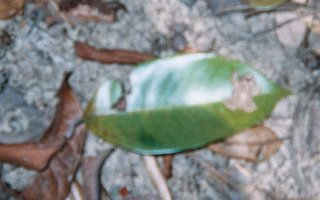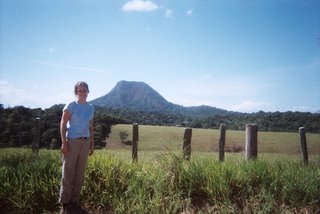We made one trip into the forest. Although we had seen rain inland on our original trip out to Corumbau, it was dry in the forest. We tried looking around in two areas: a cacao farm and the Monte Pascoal National Park.
The only things we saw at the cacao farm that remotely resembled herps were chickens. I don’t say that because chickens, like all birds, are more closely related to crocodilians than crocodilians are to any other reptiles, thus sort of rendering birds reptiles, but because they sound a hell of a lot like lizards when they’re kicking their way through underbrush.
At the cacao farm we started off moving through a cacao grove, looking under piles of leaves and flipping any logs we came across.

In this part of Brazil cacao has to be grown in the shade of larger trees to maintain the necessary high humidity. Many of these larger trees were jackfruit trees, which are pretty impressive if you’ve never seen one. The jackfruit look like huge spiky sacks and they grow straight from the trunks. Here’s Jen with a jackfruit tree in Rio.

We moved towards a creek and checked around and under rocks there. We found nothing. This was all so very disheartening because it seemed like such a great place for critters. The eco-resort worker, Jason, told us about all the snakes he had seen there a few months before.
We stopped by a pond at the edge of the woods and a pasture – another fine place to find critters. I found nothing, but Jen, who was poking around the trees, froze like she had noticed something important. I watched her turn her head to look around carefully, stare at something, and then crack up laughing.
“What?” I hollered. Jen was still laughing. Finally she pointed and shouted back, “Chickens!”
Sure enough there was a small group of scrawny chickens kicking its way through the underbrush. Jen at first had thought she had heard a large lizard – rustle, pause, rustle, pause – but then the noise had grown to sound like a group of lizards moving together (highly unlikely), until she could see them coming towards her. This is about when we figured out the digital camera wasn’t working; it would be cool to post a shot of those raggedy, little Bahian chickens.
So, in a slightly sour mood (I at least) we hopped back in the truck and headed towards the park. What’s supposed to happen when you get to the entrance is you walk through the gate, and you meet your guide – an Indian who will take you around for a tip of about ten dollars. When we showed up, though, the one adult Indian there was leaving to help fight a fire in the middle section of the park – another problem caused by the dry spell (not to say that my not finding herps is a problem on par with a forest fire).
The substitute guides were two boys, probably eight and six years old. I was dressed in boots, hiking pants, and a long sleeved shirt to keep away mosquitoes and biting flies; these guys were decked out in all of shorts and flip flops.
The air was dry and hot, and the leaves crunched underfoot as we walked. When I think of a rainforest, I think wet and muddy. Maybe the forest there is naturally drier than I expected, but the drought apparently had made things drier than they would have been otherwise. On our hike we saw some very large trees, some vines shaped like ladders that are called ‘monkey’s ladders,’ and some large leaves that when plucked and smacked hard on the base of the stem produced a loud thump like striking a drum.
We saw three types of herps while hiking around with our mini-guides. The first was a tiny toad (
Proceratophrys appendiculata) that the guides spotted. It was about as big as a nickel and had a bizarre head – a sort of a triangular shape with a pointed nose. Do you want to see the photo I took of such an interesting and bizarre creature? There, there is it on the leaf. So much for using backup disposable cameras.

A few minutes later the guides perked up. “A tegu!” they whispered. I was maybe fifth in line, but Jen was closer. Her eyes followed the line of the guides’ pointing arms and gasped. It was, she said, a large lizard, black with red and gold markings. By the time I got up close to see, it (a
Tupinambis species) was gone, but that was truly an exciting find. I used to see a lot of another species of tegu (
Tupinambis marianae) in a park in Buenos Aires when I lived there. The biggest of them, maybe four feet long, looked like dragons as they basked on the trails. I remember one giant on the other side of the fence from the park as it inspected piles of junk, checking every crack and crevice for something to dig up and eat. Tegus resemble the large Asian and African monitor lizards (
Veranus), but are more closely related to the ameiva (
Ameiva ameiva?) we saw earlier and the race-runners (
Cnemidophorus species) we’ve got here in the United States. Here are some links to tegu pictures and to shots of their smaller N. American cousins from a reptile dealer's website (
http://markmlucas.com/Monitorgallery.htm).
We hiked to a streambed. It was about twenty feet wide, but what we saw dribbled downhill from one stagnant pool to another. I did see a group of fat, black tadpoles in one of these little pools. I did not get a good photo, and I have no idea what they were.
On our way back out we nearly ran over another tegu. Again, I totally missed it. Jen was leaning forward in her seat when it flashed by on the road (I was staring out the side window), and so managed to spot her second large tegu in just a couple hours.
We rode back via the more ‘interesting’ route – bumping along over rutted dirt roads through cattle ranches and admiring the view of the park to our left. We saw no more herps, but we did see caracaras (birds of prey that seem to walk around on the ground as much as fly to look for food), and a lot of zebu, the breed of choice for ranchers in that part of the country. While we did pass some subsitence farms, most of the land is owned and worked by wealthy ranchers or farmers who live in the big cities. Most of Brazil that gets any rain is cattle country, including much of what used to be rainforest. If I ever needed another reason to not eat beef, seeing how ranching destroys the environment is it.
I don’t want to end this on too sour a note. We had a great time on this trip, and we really got an impressive tour of the countryside just inland from our resort.
Here are some shots of the countryside. Note the smoke rising from the park in the first photo.

Here's Jen posing for a shot with Monte Pascoal.








